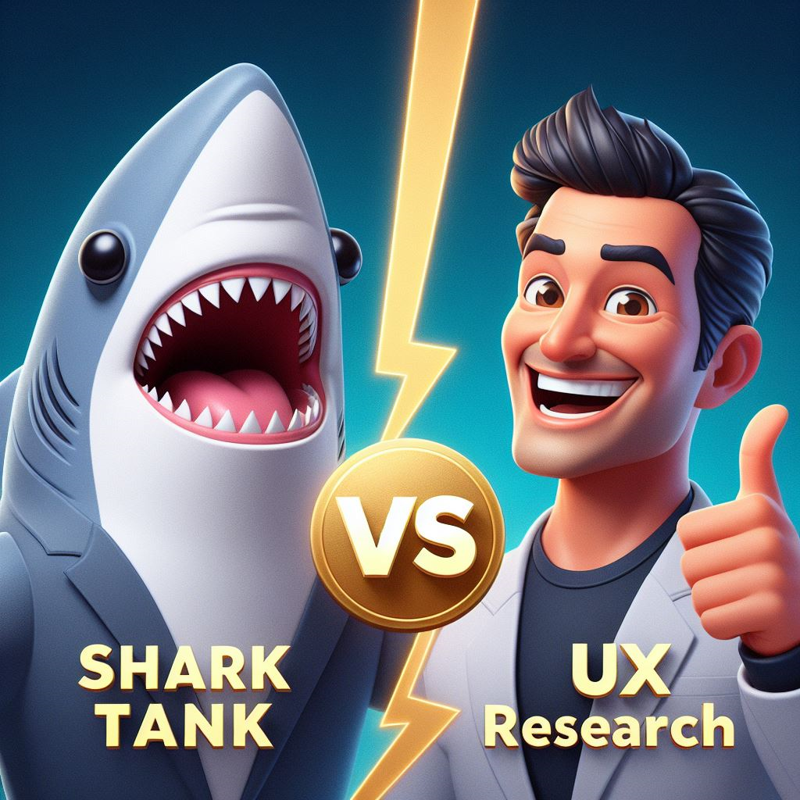
The significance of real-world research in shaping business strategies cannot be overstated. In the fast-paced and ever-evolving landscape of software development, grounding your approach in tangible, real-world data is paramount. On one hand, there’s the Shark Tank concept, embodying investor validation. This method offers a direct, unfiltered view of how potential investors perceive your business’s viability and growth potential. It’s a litmus test for your business model under the scrutinizing gaze of those who understand market dynamics and financial sustainability.
On the other hand, user experience (UX) research offers a different, yet equally vital perspective. It provides a deep dive into the needs, behaviors, and preferences of your end users. By focusing on UX, you gain invaluable insights into how your product fits into the lives of those it’s designed for, ensuring that every development decision is informed by user-centric data. Both paths offer unique benefits, and choosing the right one hinges on your specific business goals and the stage of your product’s lifecycle.
Engaging in a Shark Tank-style session can be incredibly beneficial for management teams, offering key insights from investors. In this environment, your business model, market strategies, and potential for growth are thoroughly assessed. Such investor feedback is invaluable; it gives you a clear understanding of how investors view your company, highlighting both strengths to leverage and areas for improvement.
This investor feedback significantly influences the setting of your strategic OKRs. It focuses your attention on crucial aspects like market viability and financial growth, which are vital for your company’s long-term success. This process helps in establishing ambitious yet realistic objectives, deeply rooted in market realities. Your key results evolve from simple targets to significant milestones, marking progress in financial sustainability and market reach. This investor-centric perspective ensures that your OKRs align perfectly with the demands of a competitive marketplace, turning them into powerful instruments for steering your company’s strategic path.
User Experience (UX) research, on the other hand, is crucial for deeply understanding your market and uncovering what your users truly need and prefer. This approach explores how users interact with your product, what they value, and the issues they face. Utilizing methods like interviews, usability testing, and surveys, UX research offers a comprehensive view of your product’s performance and areas needing enhancement.
The insights from UX research are key in shaping your OKRs, especially those focusing on product development and customer satisfaction. Your objectives become increasingly centered around the user, aiming to improve usability, accessibility, and the product’s overall appeal. Key results are then crafted to track progress in user engagement, satisfaction, and retention. Such an alignment ensures that every step in product development is in tune with user expectations, contributing to a product that not only meets but surpasses market needs. This user-focused approach in setting OKRs is essential for creating products that resonate with your audience and drive business success.
Clear and comprehensive communication across the company is essential in the OKR (Objectives and Key Results) setting process. It’s crucial for creating a unified organizational rhythm and a clear sense of purpose. Well-defined and thoroughly explained OKRs serve as a unifying element, aligning the efforts of every team member with the company’s overall goals. Such clarity in communication ensures that each team member not only knows their tasks but also understands the reasons behind them, fostering a shared sense of purpose and direction.
Communicating OKRs effectively helps dismantle barriers within the organization, encouraging cross-functional collaboration and enhancing understanding of how individual roles support the wider objectives. When team members grasp the larger picture and recognize their own impact, motivation and efficiency naturally increase, leading to a more cohesive and productive work environment. This systematic approach to establishing and sharing OKRs is key to maintaining operational consistency and guiding the organization towards its strategic objectives.
So the question is: how do you substantiate your OKRs? The strategic decision between investor validation and user experience (UX) research is key to operational excellence in software development. Choosing investor validation, such as the Shark Tank experience, aligns with a strategy focused on market viability and financial scalability. It’s about meeting investor expectations, securing funding, and ensuring your product aligns with market opportunities as seen by the Sharks in the Tank. This approach boosts operational efficiency by directing resources to areas with the highest potential for financial return and market impact.
On the flip side, opting for UX research aligns with a customer-centric strategy. It involves a deep understanding of user needs, enhancing product usability, and boosting customer satisfaction. This focus improves operational efficiency by creating products that truly resonate with users, thereby increasing user engagement, loyalty, and advocacy. While these paths differ, both are crucial and contribute significantly to a company’s operational excellence. Each approach enhances efficiency and effectiveness in unique yet complementary ways, demonstrating the importance of strategic choice in software development.
If you’re seeking further guidance or support in navigating the crucial choices on your road ahead, or in effectively setting and implementing OKRs, our team is here to assist. We specialize in offering bespoke training and coaching to integrate these techniques seamlessly into your organization. Our services range from evaluating your current processes to fine-tuning your performance, ensuring a successful adoption of the strategies that best suit your business needs. Remember, the journey to operational excellence and strategic decision-making is as much about people as it is about processes. 😀
Here’s a list of links to additional resources:
Curious how Xablu can help your organization ?